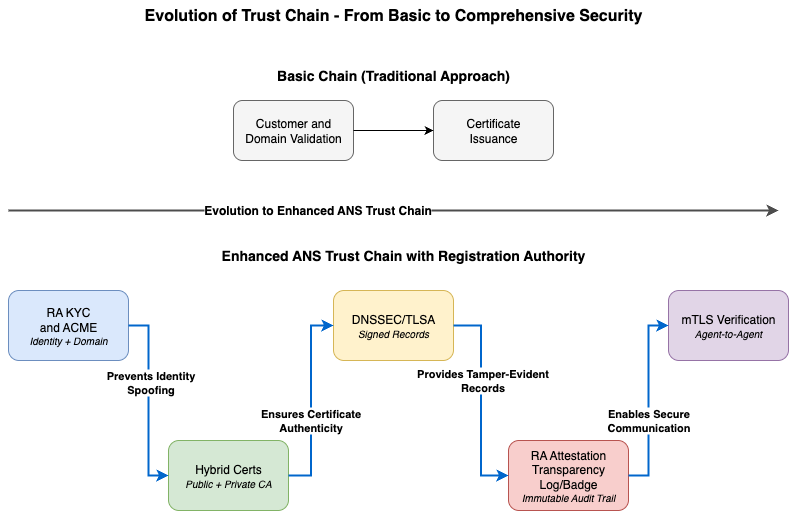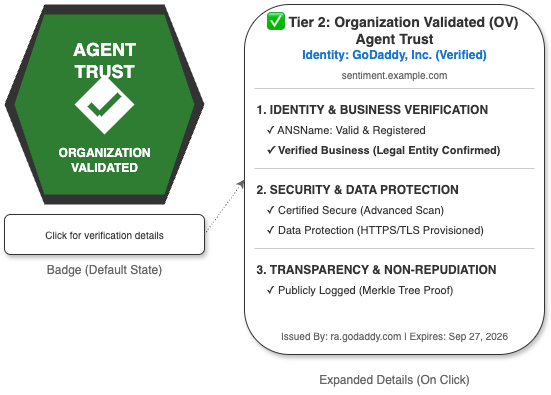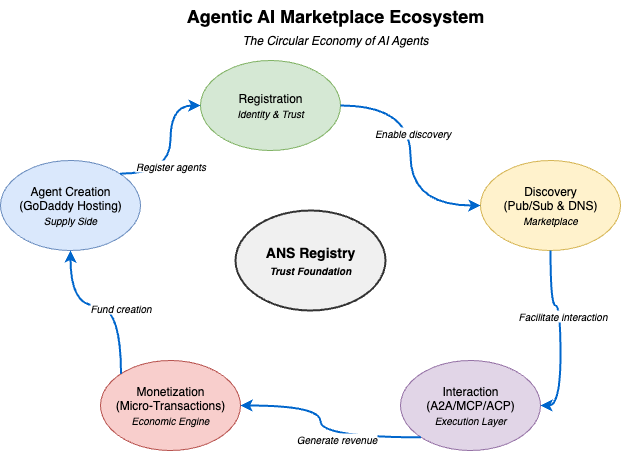As AI brokers proliferate throughout the web, a vital query emerges: how do brokers uncover and belief one another at scale? At GoDaddy, we’re addressing this problem by growing an enhanced Agent Title Service (ANS) Registry with a Registration Authority (RA) that builds on rising IETF, OWASP, and agent communication protocol requirements whereas including the operational automation and cryptographic rigidity wanted for real-world deployment. On this weblog publish, we offer a proof-of-concept demonstrating find out how to create a verifiable belief chain from prospects and their brokers by means of the DNS, certificates authorities (CAs), and transparency logs.
The problem of agent identification and discovery
Image this: You have constructed an AI agent that analyzes buyer sentiment in real-time. And it detects a buyer grievance written in Spanish! However to resolve that grievance, your agent must collaborate … and it instantly runs right into a collection of roadblocks:
First, it must translate the grievance. It searches for an agent with a translation functionality, and finds a number of choices. Which one is reliable? Which one is cost-effective? There is not any “telephone e book” to test.
After guessing at a translation agent, it must route the grievance. It appears for a customer-service-triage agent for the person’s account. It finds one, however how can it make certain it is the professional agent and never a malicious imposter attempting to intercept buyer information? There is not any strategy to confirm its identification.
Lastly, the triage agent decides to concern a small refund and must name a billing agent. How can it securely authorize a fee transaction? With out a trusted identification infrastructure, it is too dangerous.
The duty fails. Your agent is an island. The present panorama resembles the early internet: useful protocols exist, however with no trusted listing, no identification verification, and no safe strategy to transact, scalable collaboration is unimaginable.
The AI ecosystem is experiencing explosive, if nascent, progress. Trade analysts venture billions of brokers working by 2030, but elementary infrastructure challenges stay unsolved throughout the web:
- Discovery: How does an agent discover different brokers with particular capabilities?
- Identification: How can brokers confirm they’re speaking with professional entities?
- Immutability: How can we guarantee agent identification is tamper-proof and traceable over time?
Rising requirements deal with items of this puzzle; nonetheless, they lack the operational automation and belief mechanisms wanted for sustained internet-scale deployment.
GoDaddy’s enhanced ANS Registry: bridging idea to actuality
Our enhanced ANS Registry introduces a registration authority because the central orchestrator. In leveraging GoDaddy’s present infrastructure, we have created a system that makes agent registration as easy as area registration, with absolute identification integrity because the core precept.
ANSName immutability
In our enhanced design, the total ANSName is handled as a main key. Any change to any of its elements, even a minor model increment, forces the creation of a brand new, distinctive, ANSName. The identification certificates for the previous identify is straight away revoked, and a brand new entry is sealed within the transparency log, making a everlasting, auditable file of the model change.
The structured ANS Title format consists of six distinct elements: Protocol://AgentID.Functionality.Supplier.vX.Y.Z.Extension
This builds from the IETF narajala-draft doc. Our format strictly defines the agent’s communication protocol, its distinctive hostname (AgentID), its main perform (Functionality), its verified proprietor (ProviderID), its software program model, and the DNS area zone (Extension) that acts as its belief anchor. Any change to those elements requires a brand new registration.
The structure: acquainted patterns, new function
The breakthrough got here after we realized we did not have to reinvent the web’s infrastructure; we merely wanted to increase it. The web already has two huge, battle-tested hierarchies that deal with identification and discovery at a worldwide scale: the Area Title System for organizing assets hierarchically and the CA system for establishing cryptographic belief.
We requested: what if agent identification might work identical to internet server identification? As a substitute of making new protocols from scratch, we might construct agent discovery on DNS, the identical system that presently handles multiple hundred million requests every second, and we might set up belief by means of the identical PKI infrastructure that secures each HTTPS connection. The improved ANS/RA structure intentionally integrates with these confirmed techniques: DNS offers scalable, hierarchical discovery whereas CAs set up cryptographic belief.
The next diagram illustrates full ANS registration circulate displaying the brand new orchestration function supplied by the RA:
The belief chain: cryptography at each hyperlink
Our implementation creates a complete belief chain that’s verifiable at every step:
- Buyer verification: Know-your-customer processes validate the agent supplier’s identification.
- Area validation: ACME DNS-01 challenges show area possession.
- Hybrid certificates: Public CA points customary TLS certificates; personal CA points identification certificates with customized ANS extensions.
- DNS provisioning: DNSSEC validation ensures your complete belief chain for the agent’s area is cryptographically secured towards hijacking.
- Transparency logging: Merkle tree-based attestation offers an immutable audit path, sealing the identification and attestation outcomes.
Every hyperlink makes use of established cryptographic requirements, creating protection in depth towards impersonation and tampering. The next diagram illustrates the evolution from fundamental validation to complete cryptographic belief chain:

Agent registration in follow
Think about you’ve got constructed a sentiment evaluation service and need different AI brokers to find and use it. Here is how our ANS Registry transforms this from a guide, error-prone course of into one thing so simple as registering a site utilizing the ANS format and lifecycle guidelines.
Step 1: Submission
An agent supplier submits their registration with an ANS identify following our structured format:
mcp://sentimentAnalyzer.textAnalysis.AcmeCorp.v1.0.instance.com
This strictly encodes the protocol (MCP), AgentID (sentimentAnalyzer), functionality (textAnalysis), supplier (AcmeCorp), model (v1.0.0), and extension (instance.com).
Step 2: Validation and certificates issuance
The RA validates the supplier’s identification and area management. It then orchestrates the issuance of two certificates as outlined in our hybrid mannequin: a public server certificates for the agent’s endpoint (that is the usual TLS certificates used to safe its public HTTPS site visitors), and a non-public identification certificates that cryptographically binds the agent’s key to its full, immutable ANSName, which is used for safe agent-to-agent signing.
Step 3: DNS provisioning
The system provisions a number of DNS file sorts for complete discovery:
; Factors to the Agent Card, a metadata file hosted by the agent supplier
_ans.sentiment IN TXT "url=https://sentiment.instance.com/agent-card.json"
; Service endpoint
_mcp._tcp.sentiment IN HTTPS 1 . alpn=h2 port=443
; Certificates pinning for added safety
_443._tcp.sentiment IN TLSA 3 1 1 [cert_hash]
; RA attestation badge dynamically hosted on the RA
_ra-badge.sentiment IN TXT "v=ra-badge1; url=https://transparency.instance.com/reg-abc123"Step 4: Transparency and attestation
Each profitable registration or standing change creates a brand new, immutable log entry. This file explicitly contains the cryptographic fingerprints and the hash of the agent’s configuration.
{
"log_id": "reg-abc123",
"ans_name": "mcp://sentimentAnalyzer.textAnalysis.PID-1234.v1.0.0.instance.com",
"timestamp": "2025-01-24T10:00:00Z",
"standing": "VERIFIED",
"validation_summary": {
"domainControl": "success",
"organizationIdentity": "success",
"dnssec": "success"
}
}The next picture depicts the RA Attestation Badge, which visualizes the cryptographic proof and validation checks from the transparency log:

Classes from the POC
Our proof-of-concept implementation demonstrates a number of key architectural selections that any group constructing related infrastructure would want to contemplate:
- Area-driven design for complicated enterprise logic – We structured our code utilizing domain-driven design ideas to handle the system’s complexity, making certain a transparent separation between enterprise guidelines and technical infrastructure.
- Practical error dealing with – Our implementation makes use of useful programming ideas to deal with errors gracefully and predictably, avoiding sudden exceptions and making the system extra sturdy.
- Idempotent operations at scale – Each core operation is designed to be idempotent, that means API requests could be safely retried with out creating duplicate registrations or inflicting unintended unwanted effects.
Enabling the agentic market
The next diagram illustrates the round financial system of AI brokers enabled by the ANS Registry:

Past technical infrastructure, our ANS Registry allows new financial fashions for AI brokers:
Discovery markets
Brokers can promote their capabilities by means of the registry, and impartial discovery companies subscribe to the registry’s public pub/sub feed to construct their very own searchable indexes. For instance, an LLM-powered discovery chatbot continuously indexes this feed. A person or agent can then discover different brokers by means of a easy, pure language dialog:
Person: Discover me an agent with sentiment evaluation capabilities.
Discovery Bot: I discovered two registered brokers. Agent A presents pay-per-request, and Agent B presents a month-to-month subscription. Listed below are their particulars:
[
{
"ansName": "mcp://sentiment.analytics.PID-1234.v2.0.0.provider1.com",
"endpoint": "https://sentiment.provider1.com",
"pricing": "0.001 USD per request"
},
{
"ansName": "a2a://emotions.analysis.PID-5678.v1.5.0.provider2.com",
"endpoint": "https://emotions.provider2.com",
"pricing": "subscription: 100 USD/month"
}
]Monetization by means of cryptographic attribution
The system allows safe, attributable billing for agent companies. Through the use of its personal Identification Certificates to cryptographically signal requests, an agent can show its identification to a different agent. This permits the receiving agent to confidently invoice for companies, for instance by responding with a typical HTTP 402 (Fee Required) standing to provoke a transaction.
Platform alternatives
Whereas any of those could be supplied by impartial suppliers out there, GoDaddy is creating every of the service streams:
- Agent internet hosting: Managed infrastructure for agent deployment.
- Registration companies: ANS registration analogous to area registration.
- Certificates administration: Automated renewal and lifecycle administration.
- Discovery market: Fee-based agent market.
- Analytics and monitoring: Insights into agent interactions and efficiency.
Protection in depth
Our implementation addresses the next menace vectors:
- Area hijacking prevention – ACME DNS-01 validation ensures solely professional area house owners can register brokers. This prevents a malicious actor from registering an agent for a site they don’t truly management, thwarting impersonation on the area degree. We already use it in a number of elements of our enterprise.
- Certificates pinning by way of DANE – TLSA information in DNS present out-of-band certificates verification. This permits a consumer to confirm an agent’s certificates straight towards DNS, even within the unlikely occasion of a CA compromise.
- Transparency for accountability – Each motion is logged with cryptographic proof. This creates a public, tamper-evident audit path, permitting any third get together to independently confirm an agent’s registration historical past and make sure that the log has not been secretly altered.
Variations from rising requirements
Our implementation makes deliberate selections that differ from nascent requirements. The next desk illustrates the important thing variations and our rationale for every divergence:
| Commonplace | Adjustments Made | Rationale |
|---|---|---|
| IETF ANS draft | Added: RA orchestration, automated lifecycle administration, transparency logs | The RA’s function is exactly so as to add the operationalization that strikes the IETF customary from a naming conference draft right into a deployable, auditable system |
| OWASP GenAI ANS | Added: Hybrid certificates, Area Join integration | Our system emphasizes public TLS + personal identification and automatic DNS provisioning as core differentiators enabling sturdy belief fashions |
| A2A/MCP protocols | Added: DNS-based discovery layer | These protocols concentrate on agent-to-agent communication after discovery. Our ANS/RA offers the DNS-based discovery layer that acts because the lacking foundational infrastructure |
| Blockchain approaches | Totally different: Makes use of DNS as a substitute of blockchain | The specific alternative to make use of DNS, PKI, and Merkle Logs over a completely distributed blockchain ledger is an architectural distinction to leverage present, scalable web infrastructure |
Infrastructure for the agentic future
The improved ANS Registry with RA represents greater than a technical implementation. It’s foundational infrastructure for the rising agentic financial system. By constructing on confirmed web requirements whereas including vital automation and belief mechanisms, we’re creating the situations for AI brokers to find, confirm, and transact with one another at web scale.
Simply as GoDaddy has been instrumental in making area registration accessible to our 20 million prospects, we’re now working to make agent registration equally easy. The belief chain we have constructed ensures that the agentic market can develop securely and reliably by integrating:
- Buyer Verification
- Area Validation
- Hybrid Certificates Issuance
- DNSSEC-signed DNS Provisioning
- Immutable Transparency Logging
As we transfer towards a future the place billions of brokers coordinate to unravel complicated issues, the infrastructure we construct in the present day will decide whether or not that future is safe, scalable, and accessible to all. At GoDaddy, we’re dedicated to creating that imaginative and prescient a actuality.
We’re actively in search of suggestions from the developer neighborhood. In case you’re constructing AI brokers or multi-agent techniques, we would love to listen to about your challenges and use circumstances. We’re additionally launching a developer preview within the coming weeks. When you’ve got suggestions or have an interest within the being part of the developer preview, contact us at GDANS@godaddy.com.









